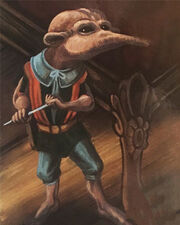Killmoulis (pronounced: /kɪlˈmuːlɪs/ kil-MOO-lis[7]; sing & pl) were tiny, large-nosed fey who lived in symbiotic relationships with bigger humanoids.[2][3][4]
Description[]
A killmoulis was something like a thin brownie[3][4] with an extra-large head[2][4] and even larger nose[2][3][4] and ears.[4] They did not have mouths[2][4] or chins[2] at all. They rarely reached 1 foot (30 centimeters) in height.[2][3][4]
Personality[]
They were generally inoffensive beings,[2] neutral in their moral and ethical alignment but leaning more toward chaotic good.[2][4] Like many fey, they loved practical jokes. These jokes were usually harmless fun, but if anyone tried to harm the killmoulis, they would change their pranks into destructive ones,[2][4] though rarely directly fatal.[2]
Killmoulis were extraordinarily shy. They enjoyed being around "big folk" and spent time secretly observing their behaviors, but killmoulis were terrified to ever be seen by them, fleeing in abject terror if spotted and potentially even dropping dead if caught.[2]
It was possible to befriend a killmoulis indirectly, however, by leaving gifts such as warm food or clothing.[2]
Killmoulis tended to share the interests of tradesmen and farmers. They were prone to gossip, and shared tales with each other of past friends and enemies and the best ways to perform jobs.[2]
Abilities[]
Killmoulis were very fast[2][4] and adept at hiding themselves.[2][3][4] They communicated with each other telepathically, since they had no vocal capacity.[2][4] If a killmoulis "befriended" another creature, it was sometimes possible to perceive their communicated thoughts in the form of pleasant feelings. This could result in a plethora of information, since the killmoulis shared so much gossip with each other.[2]
Combat[]
Killmoulis tried to kill cats, dogs, and rats, for these animals always attacked them. They usually found ways to poison cats and dogs, but they would skewer rats with long needles.[2][4] They rarely had any reason or ability to attack humans or demihumans.[2]
Society[]

A spiffy killmoulis.
They kept small bits of treasure that they had scavenged in life or stolen from cruel "big people", but they were happy to share their belongings.[2]
Diet[]
Without mouths, killmoulis could not eat. To consume food, they instead snorted it up their long noses.[2][4]
Reproduction[]
The reproductive methods of killmoulis were a curiosity among scholars of sylvan creatures. They had no noticeable external sexual organs, but it was assumed that they must reproduce sexually somehow, as did most other fey. However, they certainly did not nurse their young, as they had neither mouths nor mammary glands. It was postulated that infant killmoulis must be born with the ability to suck up their food. Theories on these topics were difficult to prove, as no young killmoulis had ever been observed by "big people".[2]
Homelands[]
These tiny faerie people were found wherever there was industry, especially if that industry involved foodstuffs, such as mills or granaries.[2][3][4] They lived in cramped spaces in walls or under floors,[2][3][4] only coming out when the owners of the establishment were gone.[2][4] They were a mix of benefit and detriment to the property owners, for they did useful work to help but also consumed vast amounts of food.[2][4] They were skilled at many basic tasks, and usually the helpful work that they performed outweighed the cost of the food that they ate. They could also be useful for pest control and to alert owners to signs of fires or other property hazards.[2]
Killmoulis would move to new locations if they found themselves unable to kill all the cats, dogs, or rats in a location.[2][4]
Religions[]
Killmoulis worshiped the faerie god Caoimhin,[5][6] a god acknowledged by the elves of Faerûn.[8] They were considered a favored monster of the deity Sheela Peryroyl.[9]
History[]
Most scholars thought that killmoulis were related to brownies.[2][3]
In the mid-14th century DR, the tavern The Misty Beard was noted for having killmoulis among their staff.[10]
Trivia[]
Priests of Erevan Ilesere were capable of assuming the form of a killmoulis through use of the spell faerie form.[11]
Appendix[]
| This article is incomplete. It needs information from Mordenkainen's Fiendish Folio, Volume 1: Monsters Malevolent and Benign. You can help the Forgotten Realms Wiki by providing more information. |
See Also[]
Further Reading[]
- Vince Garcia (March 1990). “The Folk of the Faerie Kingdom”. In Roger E. Moore ed. Dragon #155 (TSR, Inc.), pp. 34–36.
References[]
- ↑ Mike Mearls, Bart Carroll, Bill Benham (December 2019). Mordenkainen's Fiendish Folio, Volume 1: Monsters Malevolent and Benign. (Wizards of the Coast).
- ↑ 2.00 2.01 2.02 2.03 2.04 2.05 2.06 2.07 2.08 2.09 2.10 2.11 2.12 2.13 2.14 2.15 2.16 2.17 2.18 2.19 2.20 2.21 2.22 2.23 2.24 2.25 2.26 2.27 2.28 2.29 2.30 2.31 David "Zeb" Cook, et al. (1989). Monstrous Compendium Volume Two. (TSR, Inc). ISBN 0-8803-8753-X.
- ↑ 3.00 3.01 3.02 3.03 3.04 3.05 3.06 3.07 3.08 3.09 3.10 Doug Stewart (June 1993). Monstrous Manual. (TSR, Inc), p. 31. ISBN 1-5607-6619-0.
- ↑ 4.00 4.01 4.02 4.03 4.04 4.05 4.06 4.07 4.08 4.09 4.10 4.11 4.12 4.13 4.14 4.15 4.16 4.17 4.18 4.19 4.20 Don Turnbull (1981). Fiend Folio. (TSR Hobbies), p. 57. ISBN 0-9356-9621-0.
- ↑ 5.0 5.1 Carl Sargent (May 1992). Monster Mythology. (TSR, Inc), p. 120. ISBN 1-5607-6362-0.
- ↑ 6.0 6.1 Colin McComb (October 1996). On Hallowed Ground. Edited by Ray Vallese. (TSR, Inc.), p. 175. ISBN 0-7869-0430-5.
- ↑ Frank Mentzer (January 1985). “Ay pronunseeAYshun gyd”. In Kim Mohan ed. Dragon #93 (TSR, Inc.), p. 26.
- ↑ Eric L. Boyd (November 1998). Demihuman Deities. Edited by Julia Martin. (TSR, Inc.), p. 92. ISBN 0-7869-1239-1.
- ↑ Eric L. Boyd (November 1998). Demihuman Deities. Edited by Julia Martin. (TSR, Inc.), p. 172. ISBN 0-7869-1239-1.
- ↑ Ed Greenwood (January 1993). Volo's Guide to Waterdeep. (TSR, Inc.), p. 90. ISBN 1-56076-335-3.
- ↑ Eric L. Boyd (November 1998). Demihuman Deities. Edited by Julia Martin. (TSR, Inc.), p. 111. ISBN 0-7869-1239-1.
